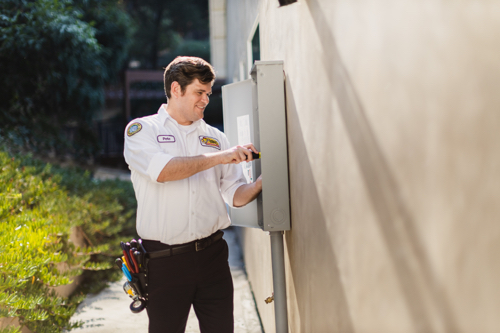How Lightning Impacts Electrical Systems
The possibility that a lightning strike might sweep through your home’s entire electrical system is a scary thought. Modern life is built around power-hungry HVACs, appliances and devices that can be costly to replace after a strike.
Fortunately, there are plenty of ways to reduce the risks of such a huge electrical surge. However, homeowners need to understand what a strike entails so they can find the right solution.
Science
When a bolt hits a structure or the ground, it seeks the best available path so it can discharge its energy. If this means going through your home’s electrical system and passing through devices, the lightning doesn’t care.
While such strikes typically only last for microseconds, they can impart tens of thousands of volts of electricity. The worst direct strikes top 100,000 volts, but the high end for most scenarios is between 30,000 and 50,000 volts. For some reference, your typical household devices employ 120 or 240 volts.
The amperage imparted from a strike is also considerable, usually reaching about 30,000 amps during a direct hit. Your home’s electrical system is usually rated for about 200 amps, although some older houses have electrical panels that only support 100 amps. Even at a large commercial operation with heavy machinery, the total system might require 6,000 amps across a distributed power system. Simply put, no electrical system is equipped to handle a strike on its own.
Be aware that these voltages aren’t the only ones that can hit your house. Transient electrical surges can push through systems at levels closer to 1,000 volts. Also, smaller surges can occur following storms as the utility company reconnects systems.
Direct vs. Indirect Lightning Strikes
A direct strike is when lightning hits a structure or a service pole. An indirect strike involves the lightning hitting the nearby grid, the ground or another structure in the vicinity. Typically, indirect strikes surge energy through your home via electrical pathways like power lines or communications systems.
An indirect strike might sound less worrisome. However, an indirect strike can still impart 6,000 volts into your home’s electrical system. Notably, this means your whole electrical system is less likely to suffer failure. At the same time, you can expect circuit boards, electrical panels and circuit breakers to all suffer damage.
Scarier yet, insulation in your home’s wiring system could melt. What makes that particularly worrying is that a strike doesn’t always pose an immediate fire risk. Instead, the exposed wiring could keep functioning in your home’s walls. A fire caused by a strike melting wires might not happen for years after a storm.
Bear in mind the risks associated with a direct strike are similar. The big difference is the damage from a direct strike tends to be more total, especially when it comes to destroying electrical panels, wiring and devices.
Household Vulnerabilities
In addition to your electrical system’s core, connected devices tend to also be at risk. Telephone lines and cable systems, for example, can transmit electricity from a strike. Exterior HVAC components also often attract electricity from nearby strikes.
A lot of modern equipment uses sensitive electronics for sensors, processing units, microcontrollers and variable-speed motors. These are components that can suffer damage from low-voltage shocks that occur normally in a home from things like static electricity or brief electrical system instability, let alone lightning.
Many of the components that protect your home’s electrical system can suffer damage that doesn’t lead to immediate failure, too. For example, thermal stress can shorten the life spans of electrical panels, circuit breakers and wiring. This can lead to more frequent breaker trips that present further risks to your home’s system years down the road.
Protecting Your Electrical Home’s System
Two systems do most of the work of protecting your home’s electrical system when storms hit. First, the grounding system gives electrical overloads a path out of your house. An electrician plants a rod into the ground, usually near or under your house, to send overloads away from sensitive devices. However, the grounding system is predominantly meant to dissipate overloads from devices in your home.
The second system is the more relevant one when it comes to lightning strikes. A whole-house surge protector connects your home’s electrical panel to the grounding system. This provides a path that bypasses everything in your house. If all goes well, the electricity from your panel will continue to flow as normal while the energy from the strike passes into the ground. However, a surge protector can burn itself out in extreme cases to try to prevent the flow of electricity into your house.
Many people use smaller standalone surge protectors near equipment like computers, TVs and phone chargers. However, these systems offer nothing like the protection from a whole-house system. A surge protection power strip relies on the grounding system within your home, rather than stepping in before a surge gets that far.
They also degrade quickly with every strike, meaning they may continue to appear operational after they’ve stopped providing full protection. Consequently, we strongly recommend adopting a whole-house system that’s rated for tens of thousands of volts.
Another benefit is that a whole-home surge protector reduces the risk that a strike will seek an alternate path through your house. For example, a strike might try to get to the ground through plumbing pipes or even your HVAC ductwork.
Damage, Costs and Insurance Implications
The typical residential lightning claim is worth more than $15,000, with damaged HVAC units often comprising the bulk of that number. Also, you should understand what your homeowners’ insurance policy does and doesn’t cover. For example, many policies only cover direct strikes because these are much less common.
Mr. Sparky offers whole-house surge protection and grounding systems to Melbourne, FL, residents. Contact Mr. Sparky today to discuss the options for protecting your house from a lightning strike.
